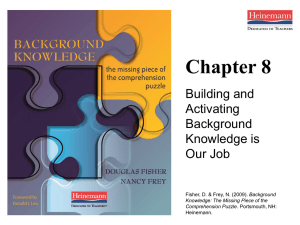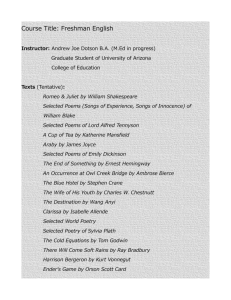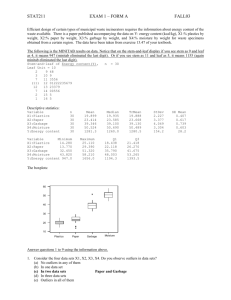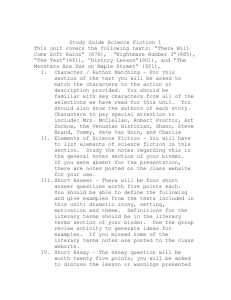Using Critical Theory to Interpret Literature
advertisement
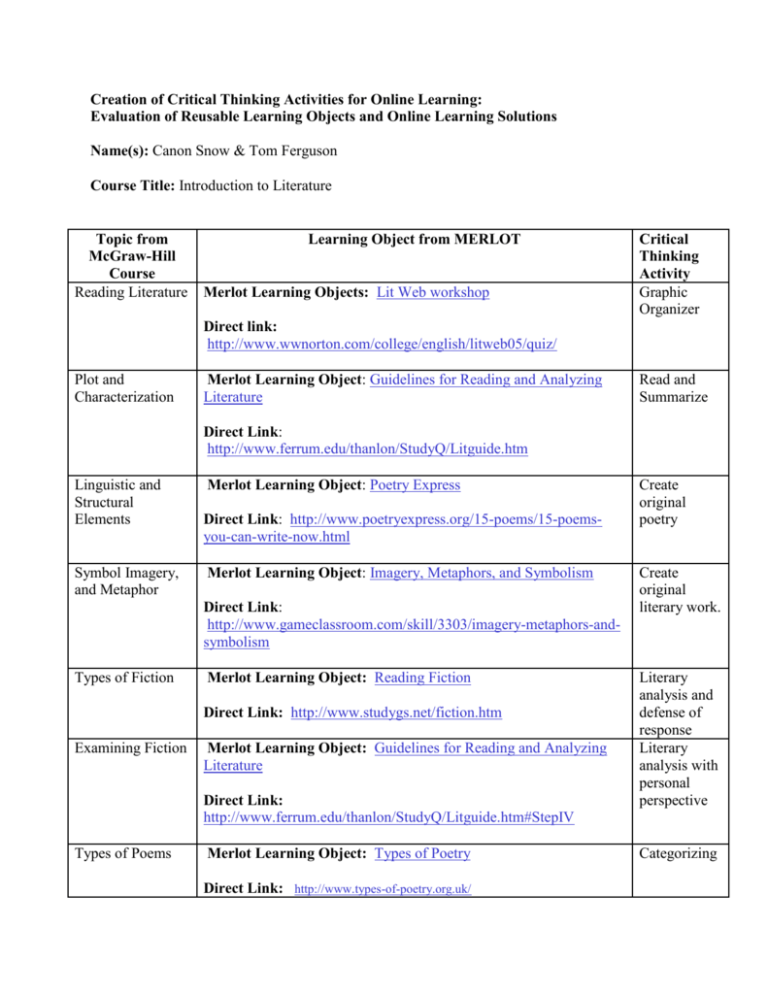
Creation of Critical Thinking Activities for Online Learning: Evaluation of Reusable Learning Objects and Online Learning Solutions Name(s): Canon Snow & Tom Ferguson Course Title: Introduction to Literature Topic from McGraw-Hill Course Reading Literature Learning Object from MERLOT Merlot Learning Objects: Lit Web workshop Critical Thinking Activity Graphic Organizer Direct link: http://www.wwnorton.com/college/english/litweb05/quiz/ Plot and Characterization Merlot Learning Object: Guidelines for Reading and Analyzing Literature Read and Summarize Direct Link: http://www.ferrum.edu/thanlon/StudyQ/Litguide.htm Linguistic and Structural Elements Symbol Imagery, and Metaphor Merlot Learning Object: Poetry Express Direct Link: http://www.poetryexpress.org/15-poems/15-poemsyou-can-write-now.html Merlot Learning Object: Imagery, Metaphors, and Symbolism Direct Link: http://www.gameclassroom.com/skill/3303/imagery-metaphors-andsymbolism Types of Fiction Merlot Learning Object: Reading Fiction Direct Link: http://www.studygs.net/fiction.htm Examining Fiction Merlot Learning Object: Guidelines for Reading and Analyzing Literature Direct Link: http://www.ferrum.edu/thanlon/StudyQ/Litguide.htm#StepIV Types of Poems Merlot Learning Object: Types of Poetry Direct Link: http://www.types-of-poetry.org.uk/ Create original poetry Create original literary work. Literary analysis and defense of response Literary analysis with personal perspective Categorizing Examining Poetry Merlot Learning Object: The Academy of American Poets Teaching Poetry Direct Link: http://www.poets.org/page.php/prmID/59 Recognizing Types of Theater Merlot Learning Object: WebQuest Page Literary analysis and creation of original presentation Creation of Webquest Direct Link: http://webquest.org/index-create.php Examining Theater Merlot Learning Object: Examining Theater http://onlinelearning.mhhe.com/demos/introduction_to_literature_V5_a.9/ Comparison of one’s own experiences with those of literary characters Literary analysis with creation of original work Merlot Learning Object: Writing about Literature Direct Link: http://www.tommarch.com/electraguide/ Creation of thesis Direct Link: http://internetshakespeare.uvic.ca/Library/plays/Rom.html Exploring Nonfiction Writing About Literature Merlot Learning Object: Exploring Nonfiction Direct Link: Using Critical Merlot Learning Object: Using Critical Theory to Interpret Literature Theory to Interpret Direct Link: http://www.merlot.org/merlot/viewMaterial.htm?id=397317 Literature Writing Research Merlot Learning Object: Writing Research Papers Papers Direct Link: http://valley.lib.virginia.edu/ Explore cultural phenomenon Inference Reading Literature Learning Objectives: Students will demonstrate their knowledge of the following three major literary genres via a series of online quizzes: Drama, fiction, and poetry. Students will be expected to score at 80% or higher out of 20 questions. Merlot Learning Objects: Lit Web workshop (Editors Choice) Direct link: http://www.wwnorton.com/college/english/litweb05/quiz/ Critical Thinking Activity: Students will create a graphic organizer within Word or PowerPoint that displays the characteristics of drama, fiction, and poetry. Students will include with their graphic organizer the scores they obtained on the online quizzes from the Lit Web Workshop learning object. Plot and Characterization Learning Objectives: Students will identify point of view in a given literary work. Merlot Learning Object: Guidelines for Reading and Analyzing Literature Direct Link: http://www.ferrum.edu/thanlon/StudyQ/Litguide.htm Critical Thinking Activity: Students be asked to read the point of view section of the Guidelines for Reading and Analyzing Literature learning object. Students will then paraphrase what they have read in a Word, or Google Docs. Students will then be assigned a set of short stories and required to identify the point of view from which each is told. They will support their conclusion with examples from the stories. Linguistic and Structural Elements Learning Objectives: Students will create original poems that incorporate the use of assonance and alliteration. Merlot Learning Object: Poetry Express Direct Link: http://www.poetryexpress.org/15-poems/15-poems-you-can-writenow.html Critical Thinking Activity: After being shown examples of alliteration and assonance, students would then be asked to incorporate these literary devices in their own original poems. Poems topics could be original, or students could choose from a list of pregenerated topics from the Poetry Express website. Finished works will be submitted in Word, PDF, or Google Doc format. Symbol, Imagery, and Metaphor Learning Objectives: Students will compare and contrast simile and metaphor in literary works. Merlot Learning Object: Imagery, Metaphors, and Symbolism Direct Link: http://www.gameclassroom.com/skill/3303/imagery-metaphors-andsymbolism Critical Thinking Activity: After being shown several examples of similes and metaphors within literature, students will first be asked to review the material on the Imagery, Metaphors, and Symbolism learning object and then answer the extra help problems found at the bottom of the page. After reviewing the answers to the problems, students will be asked to create two examples for each of these literary devices. Students will share their works with one another verbally before submitting the assignment. Types of Fiction Learning Objectives: Students will distinguish between different types of short fiction and list their characteristics. Merlot Learning Object: Reading Fiction Direct Link: http://www.studygs.net/fiction.htm Critical Thinking Activity: Before beginning the activity students will review the framework provided on the Reading Fiction learning object and take notes on the questions they should be answering about fiction stories when reading. After this primer, students will create graphic organizers representing the different types of fiction and their characteristics: Short stories, novellas, and novels Commercial vs. literary Genre - mystery, romance, science fiction/fantasy, suspense thriller, horror, etc. Students will then be given a list of various stories (with descriptions) and asked to place them in the proper categories. Students will be expected to verbally defend their placements. Examining Fiction Learning Objectives: Students will describe how their own life experience with particular themes allows them to read a story more critically. Merlot Learning Object: Guidelines for Reading and Analyzing Literature Direct Link: http://www.ferrum.edu/thanlon/StudyQ/Litguide.htm#StepIV Critical Thinking Activity: Students will read about themes in the Guidelines for Reading and Analyzing Literature learning object. Working in small groups students will discuss and summarize in writing what they look for to determine the theme of a literary work. Students will then be asked to choose a story they have read that had a theme in which they could relate based on their past life experiences. Students will write a short essay describing how those experiences shaped their analysis of the story. Types of Poems Learning Objectives: Students will classify epic poetry and ballads. Merlot Learning Object: Types of Poetry Direct Link: http://www.types-of-poetry.org.uk/ Critical Thinking Activity: Using the Types of Poetry learning object from Merlot, students will read the formal definitions of ballads and epic poems. Students will then read the example poems given for each type and compare and contrast the differences. Working in teams of two, students will display the major characteristics of each in a Google Document (this will allow collaboration). Students will then locate a poem from each type and include several lines accompanied with explanations of why the poem is an epic or ballad. . Examining Poetry Learning Objectives: Students will compare and contrast different poets’ treatments of the same theme. Merlot Learning Object: The Academy of American Poets - Teaching Poetry Direct Link: http://www.poets.org/page.php/prmID/59 Critical Thinking Activity: Using the Academy of American Poets – Teaching Poetry learning module, students will work in teams to compare various authors' poetry when writing about the same theme. Students will select a specific theme and read several poems. After reading, students will work in their collaborative learning teams to discuss how each author approached the theme differently. They will create a presentation in Google Docs to show how they were the same and how they were different. Recognizing Types of Theater Learning Objectives: Students will distinguish between the following types of theater: Tragedy, comedy, historical Greek, and Elizabethan theater. Merlot Learning Object: Web Quest Page Direct Link: http://webquest.org/index-create.php Critical Thinking Activity: Working in collaborative learning teams, students will utilize the Web Quest learning object to educate themselves about web quests. Students will peruse through the sample web quests and then begin work creating their own web quest that allows the end user to learn about the following types of theatre: Tragedies, comedies, historical Greek, and Elizabethan Theater. Students will need to use the Internet to locate appropriate sites and information that will be both informative and interesting. Then they will collaborate to build the web quest using the original one-page template. The web quest assignment will be evaluated with the following rubric. Multimedia Project : Types of Theater – Web Quest Teacher Name: Mr. Snow/ Mr. Ferguson Student Name: CATEGORY ________________________________________ 4 3 2 1 Content Covers topic indepth with details and examples. Subject knowledge is excellent. Includes essential knowledge about the topic. Subject knowledge appears to be good. Includes essential information about the topic but there are 1-2 factual errors. Content is minimal OR there are several factual errors. Organization Content is well organized using headings or bulleted lists to group related material. Uses headings or bulleted lists to organize, but the overall organization of topics appears flawed. Content is logically organized for the most part. There was no clear or logical organizational structure, just lots of facts. Attractiveness Makes excellent use of font, color, graphics, effects, etc. to enhance the presentation. Makes good use of font, color, graphics, effects, etc. to enhance to presentation. Makes use of font, color, graphics, effects, etc. but occasionally these detract from the presentation content. Use of font, color, graphics, effects etc. but these often distract from the presentaion content. Mechanics No misspellings or grammatical errors. No broken links. Three or fewer misspellings and/or mechanical errors. One broken link Four misspellings and/or grammatical errors. Two broken links. More than 4 errors in spelling or grammar. More than two broken links. Examining Theater Learning Objectives: Students will reflect on how their own life experiences either allow them to or prevent them from establishing an authentic understanding of a given play’s major theme(s). Merlot Learning Object: Examining Theater Direct Link: http://internetshakespeare.uvic.ca/Library/plays/Rom.html Critical Thinking Activity: Students will read and/or act out Shakespeare’s Romeo and Juliet (the complete text of which is available at the above direct link). Afterward, they will write a blog entry in which they explain how they can or cannot relate to the situation that the play’s titular characters went through (i.e., not being allowed to be with someone you love). Exploring Nonfiction Learning Objectives: Students will demonstrate an awareness of the potential for nonfiction texts to exhibit literary features typically associated with works of fiction (plot, theme, literary devices, etc.) Merlot Learning Object: Exploring Nonfiction Direct Link: http://onlinelearning.mhhe.com/demos/introduction_to_literature_V5_a.9/ Critical Thinking Activity: Students will watch the introduction to literature via the direct link given above. They will then read a portion of Maya Angelou’s I Know Why the Caged Bird Sings and will identify, via literary analysis (via a podcast), the presence of literary elements within Angelou’s work. Writing About Literature/Developing Thesis Statements Learning Objectives: Students will create a guiding thesis for use in writing an essay. Merlot Learning Object: Writing about Literature Direct Link: http://www.tommarch.com/electraguide/ Critical Thinking Activity: Students will navigate their ways through the thesisbuilding tutorial at the above web site and present to the class, via a Wiki, the theses on which they’ve decided for an upcoming essay assignment. Using Critical Theory to Interpret Literature Learning Objectives: Students will provide examples of literary works that reflect the ideals of feminism. Merlot Learning Object: Using Critical Theory to Interpret Literature Direct Link: http://www.merlot.org/merlot/viewMaterial.htm?id=397317 Critical Thinking Activity: Students will choose a story from the web site accessible via the direct link above and explain how one or more of its characters fulfill the ideals of feminism. This explanation can be delivered in the form of a blog entry or a Power Point presentation that depicts and provides pertinent information about the character in question. Writing Research Papers Learning Objectives: Students will use original historical documents to infer about life conditions during a specific historical period. Merlot Learning Object: Writing Research Papers Direct Link: http://valley.lib.virginia.edu/ Critical Thinking Activity: Students will read the first-hand historical documents featured at the above direct link to research what life was like for Northerners and Southerners during the Civil War. Students will create either a blog entry or Power Point presentation that compares Civil War-era life of the North to that of the South. Reflection - Creation of Critical Thinking Activities for Online Learning Canon Snow When creating critical thinking activities for any course, I like to culminate in the creation of some sort of original artifact. I think that it is important for everyone to work their way up Bloom's Taxonomy. It always begins with obtaining some new set of knowledge and applying it to complete some task. The goal however, is to take this knowledge and apply it in such a way as to create an original work. So, the critical thinking activities that I designed that involve the creation of something, I believe, are the best. Literature is a great topic for designing critical thinking activities, because it can always lead to creating an original literary work. Whether a short story, poem, or just a letter, writing is a wonderful way to incorporate higher level thinking skills. A bit challenging was the process of changing some of our objectives from their lower level skills into higher level. For example, we had some objectives that just had the learner distinguishing between various types of literature. Though a necessary skill, we needed to take it to a slightly higher level. Instead of students recognizing a particular type of poetry, we had them create original poems using the new skills and knowledge. In my opinion, the best activity is the web quest activity, which requires a group of students to create a sort of web based fieldtrip/scavenger hunt that will take them on a journey of learning about several different types of theater. It is often said that the way to truly learn something is to teach it, making the creation of a web quest a great activity. Web quests are like miniature lessons on subjects that often include information, practice, application and assessment. To make a good web quest, one has to have a firm grasp on the topic. Overall, I must say I was a little dissatisfied with the Merlot learning objects, I did not really find them all that great in terms of adding to lessons. A lot of better materials could often be found by simply performing a search in Google. Granted, it could have been the topic of our course, but I do not think I would go to Merlot for extra materials for my online course. It seemed a lot of the objects contained information that would most likely be found in any textbook. I found a few interactive quizzes, which can be good due to the instant feedback, but nothing really stuck out.

